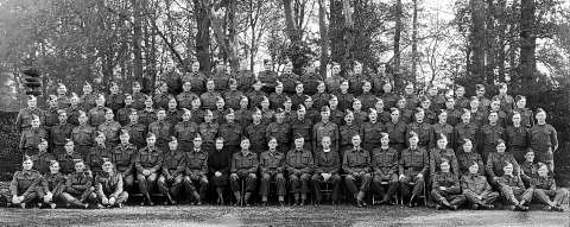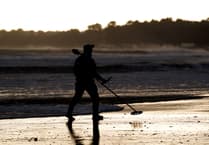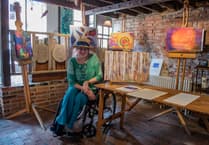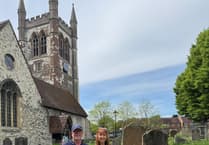OUR feature on the formation of the Home Guard in last week’s Herald certainly sparked plenty of memories of tales of how people had signed up for the Local Defence Volunteers when the call was put out by War Secretary Sir Anthony Eden as Britain feared a Nazi invasion in the aftermath of the Army’s evacuation from Dunkirk in May 1940.
Andrew Griffin unearthed some more memories of the Home Guard’s escapades while keeping the country safe between 1940 and 1944.
In the early days, thousands of men who were either too young, or too old, to serve in the regular forces signed up at their local police station – Haslemere was besieged for three days by men of all classes and backgrounds.
Meetings were held in village halls in the run-up to The Battle of Britain as the LDV formed local watches who would not only man the roadblocks that appeared all over southern England, aimed at slowing any invasion from the air by German paratroopers, while the coast and major routes and towns were fortified with tank traps, but also guard vital buildings and communication networks, such as the Post Office and the railways.
Equipment and uniform shortages may have meant the early gatherings were very much like the TV sitcom Dad’s Army, with some funny goings on and comical scenarios playing out in the long summer evenings.
But as much-needed rifles began arriving from America, the serious business of training the recruits or refreshing the veterans from The Great War and even the Boer War before it, got under way in earnest. Many of the men in North Hampshire and South West Surrey were sent to the firing ranges at Bisley, near Woking, which today is still the home of the National Rifle Association.
Avid Dad’s Army fans will remember the episode ‘Don’t Forget the Diver’ when Captain Mainwaring and the Walmington-on-Sea Home Guard were charged with capturing a windmill being guarded by Colonel Square’s men from the rival Eastgate Platoon.
Creators David Perry and Jimmy Croft did not have to invent many of the story lines for the 80 episodes recorded between 1968 and 1977 – the real life adventures of the Home Guard provided most of them.
The memories of Ken Young who served in the Fernhurst Platoon, part of Midhurst’s E Company, are typical of the story lines in the long-running BBC comedy and were recorded for posterity with the help of Ralph Lines, from the Fernhurst Centre.
Mr Young signed up as a private aged 16 in 1942, some two years after the LDV had become the Home Guard, after Prime Minister Winston Churchill dubbed the LDVs Britain’s Home Guard in a BBC radio broadcast in June 1940.
The guardroom was the office of Fernhurst Fuels, which can still be seen today.
Private Young remembered: "The original force had no recognised arms and early drill and training took place using broomsticks or 12-bore rifles which a large number of the local countrymen owned for rabbit shooting.
“One individual, a gamekeeper, retained this form of defence until the day the Home Guard was disbanded claiming that he had used his faithful 12-bore all his life and it had served him well.
“Nobody could convince him that the 300 Remington rifle eventually issued to us was as effective. This individual had some health problems, associated with his breathing, which prevented him from taking part in anything involving strenuous exercise.
“He was promoted to guard room orderly and store man which kept him out of the public eye and because of the weaponry he insisted on retaining out of the way of any possible encounters with potential invaders.”
The men attended drills in the village hall during the evening in winter months, with weapons training, first aid, and using gas masks among the many subjects needed to prepare the country to be on guard at all time in case the Nazis came calling.
In the summer, and also on Sundays throughout the year, the men would be out in the field with live firing and fighting tactics the main missions.
Mr Young added: “Once every seven to 10 days, each section of the platoon was required to be on night duty. This took place a mile outside the village at a place called Greenhill. We had a hut of sorts beside which was the wreck of an old car.
“We used to sit on the car while on guard outside the hut. From there, we could see the red glow in the sky caused by the bombing of Portsmouth and Southampton.
“Our main purpose for being there was to look out for parachuting invaders.”
The Home Guard took part in exercises with the Canadian soldiers billeted in and around the village. Mr Young said: “They were commanded by a young headstrong Lieutenant. He was not very impressed with what he considered amateurs.
“He demonstrated this one day when he ordered the Platoon to get down to Cooks Bridge to defend it against an imaginary enemy. We were formed up and marching in column of threes to the bridge when down by Collyer’s Farm we met the Lieutenant coming towards us in his jeep. Without any hesitation he drove straight at the column of men causing everyone to dive into the nearest ditch of hedge. He did actually steer away from us at the last moment and pulling up some yards past the now terrified Platoon came back and gave us a lecture on marching as a body of men in wartime conditions.
“We should have been marching in sections on alternate sides of the road. We never made that mistake again whenever he was about.”
On another occasion, the men were defending the same bridge against the enemy – the Canadians – the bridge was completely different to what it is today on the Fernhurst side of Migg Lane which was where the stream used to pass under the main road before doing a large S-bend before passing under another bridge further downstream.
Mr Young recalled: “The approach to the bridge was flanked by a very high bank on the left hand side. A section of us were positioned on top and every time the Lieutenant came by he tossed a thunderflash at us.
“We did not have any to retaliate with and were getting a bit miffed by the treatment we were receiving.
“We decided we would cut some reasonable sized turfs with our bayonets and heave them at him the next time he came by.
“Most of them came very close and a couple scored direct hits. He completely lost his rag and came storming up the bank with his bayonet drawn.
“Fortunately for us, Bert was our Sergeant that day and, in our eyes, he earned a DCM.
“He faced him directly and told him not to be so silly and should have expected us to retaliate. In all the weeks that Lieutenant was with us, I had never seen him so subdued.”
But despite the run-ins with their Allied comrades, the Fernhurst men had a begrudging respect for the Canadian officer and were saddened to learn he was killed in the ill-fated raid on Dieppe in August 1942.
Mr Young added: “He and his men gave us good training including live fire. This was conducted in the field at the back of the cottages by the police house.
“The first thing we saw on being marched into the field was an ambulance. The Lieutenant assured us it would not be needed as his men were good shots.
“We were spaced out about five yards apart and told to crawl on our stomachs for about 100 yards while the Canadians fired live rounds several feet above us. Those who had the courage to look up could see every fifth round was tracer.
“The Lieutenant amused himself by firing between each man about two feet above the ground so you could see more tracer.
“We then had to sit in a slit trench six or seven feet deep while a Bren gun carrier was driven over the top of us. We were supposed to plant sticky bombs on its underside as it passed over. The majority of us were glad it passed over – never mind the sticky bomb.”
There were plenty of laughs – often at the expense of their section sergeant, who had trouble remembering which was left and right – and like Corporal Jones’s parade drills, the young 16 and 17 olds including Ken would often end up heading in completely the opposite direction to the superior.
Arthur was a farm worker as used to working with horses as humans, and would often shout “whoa” when he realised his men were heading the wrong way, which was about 50 per cent of the time according to Mr Young – a problem not helped by the presence of a Private Holt in the ranks. If the Sergeant ever shouted “Halt!” instead of “Whoa” the men used to keep marching and Private Holt without fail would reply, “Yes, Sergeant”.
A laughing Ken added: “Needless to say whenever he called for Holt, we all to a man slammed to a halt that the smartest regular soldier would have been proud to perform.
“On important occasions like church parade, we usually knew which way he wanted us to go and would perform perfectly. But if we were on the way back from some routine task like erecting barbed wire we would obey whichever command he chose to give. Many a time we marched into the drive of the house opposite our headquarters in the village hall to the cries of, ‘Whoa, Whoa’.”
However much Dad’s Army has been a laughing matter for successive generations, the real Home Guard were ready to fight in a real war in which millions dead, civilians and military men and women alike. and Ken was immensely proud of his wartime service.
He said: “We trained with the Canadians and the regular Army and ultimately were entrusted to man every other pill box on the coast at night. This released regular troops for the more onerous tasks. With our training and local knowledge of the surrounding countryside we would have been a considerable thorn in the side of the invaders.”





Comments
This article has no comments yet. Be the first to leave a comment.